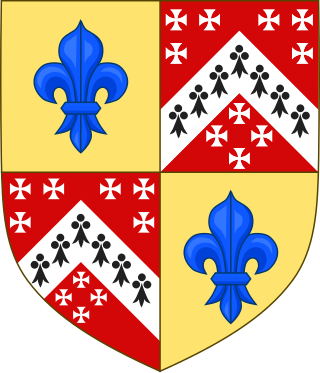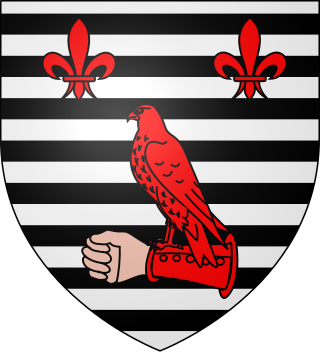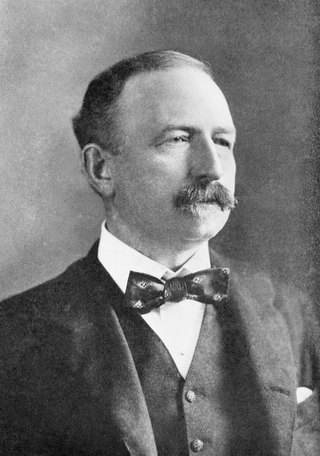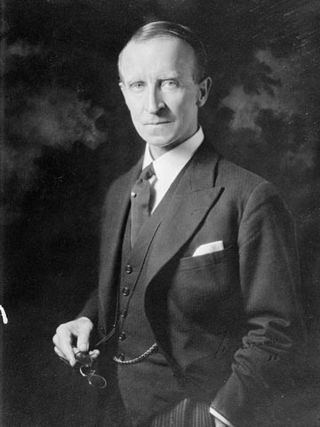
Earl Howe is a title that has been created twice in British history, for members of the Howe and Curzon-Howe family respectively. The first creation, in the Peerage of Great Britain, was in 1788 for Richard Howe, 4th Viscount Howe, but it became extinct upon his death in 1799. The second creation, in the Peerage of the United Kingdom, was in 1821 for Richard Curzon-Howe, 2nd Viscount Curzon, and it remains extant.

Earl Cowley is a title in the Peerage of the United Kingdom. It was created in 1857 for the diplomat Henry Wellesley, 2nd Baron Cowley. He was Ambassador to France from 1852 to 1867. He was made Viscount Dangan, of Dangan in the County of Meath, at the same time as he was given the earldom. This title is also in the Peerage of the United Kingdom. Lord Cowley was the eldest son of Henry Wellesley, 1st Baron Cowley, who like his son served as Ambassador to France. In 1828 he was created Baron Cowley, of Wellesley in the County of Somerset, in the Peerage of the United Kingdom. A member of the prominent Wellesley family, Cowley was the fifth and youngest son of Garret Wellesley, 1st Earl of Mornington, and the younger brother of Arthur Wellesley, 1st Duke of Wellington, and Richard Wellesley, 1st Marquess Wellesley.

Viscount Portman, in the County of Somerset, is a title in the Peerage of the United Kingdom. It was created on 28 March 1873, for the former Lord Lieutenant of Somerset and Liberal Member of Parliament Edward Portman, 1st Baron Portman. He had already been created Baron Portman, of Orchard Portman, on 27 January 1837, also in the Peerage of the United Kingdom. His son, the second Viscount, represented Shaftesbury and Dorset in the House of Commons as a Liberal. As of 2014, the titles have been held by one of the latter's great-great-grandsons, the tenth Viscount, since 1999.

Viscount Astor, of Hever Castle in the County of Kent, is a title in the Peerage of the United Kingdom. It was created in 1917 for the financier and statesman William Waldorf Astor, 1st Baron Astor. He had already been created Baron Astor, of Hever Castle in the County of Kent, in 1916, also in the Peerage of the United Kingdom.

Baron Gorell, of Brampton in the County of Derby, is a title in the Peerage of the United Kingdom. It was created on 16 February 1909 for Sir Gorell Barnes, President of the Probate, Divorce and Admiralty Division of the High Court of Justice from 1905 to 1909. His eldest son, the second Baron, was killed in the First World War and was succeeded by his younger brother, the third Baron. He notably served as Under-Secretary of State for Air between 1921 and 1922 in the coalition government of David Lloyd George. He was succeeded by his son, the fourth Baron. He was a Senior Executive of the Royal Dutch/Shell Group from 1959 to 1984. As of 2017 the title is held by his nephew, the fifth Baron, who succeeded in 2007. He is the son of the Hon. Ronald Alexander Henry Barnes.

Baron Glentoran, of Ballyalloly in the County of Down, is a title in the Peerage of the United Kingdom. It was created on 8 July 1939 for the Unionist politician Herbert Dixon. In 1950 he also succeeded his elder brother as third Baronet, of Ballymenock. His son, the second Baron, was also a politician and served as the last Speaker of the Senate of Northern Ireland. As of 2017 the titles are held by the latter's son, the third Baron, who succeeded in 1995. He is a former Olympic bobsleigh gold medallist as well as a soldier, businessman and politician. Lord Glentoran was one of the ninety elected hereditary peers who remain in the House of Lords after the passing of the House of Lords Act 1999, and sat on the Conservative benches until his June 2018 retirement under the House of Lords Reform Act 2014.

Baron Astor of Hever, of Hever Castle in the County of Kent, is a title in the Peerage of the United Kingdom. It was created in 1956 for John Jacob Astor, a prominent newspaper proprietor and Conservative politician. He was the fourth child of William Waldorf Astor, 1st Viscount Astor. Lord Astor of Hever was succeeded in 1971 by his eldest son, the second Baron, who served as Lord Lieutenant of Kent between 1972 and 1982.
Baron Skelmersdale, of Skelmersdale in the County Palatine of Lancaster, is a title in the Peerage of the United Kingdom. It was created in 1828 for the former Member of Parliament for Westbury, Newcastle-under-Lyme, Clitheroe and Dover, Edward Bootle-Wilbraham. His grandson, the second Baron, was a Conservative politician and served in the Conservative administrations of Disraeli and Lord Salisbury. In 1880 he was created Earl of Lathom, in the County Palatine of Lancaster, in the Peerage of the United Kingdom. However, the earldom became extinct on the death of his grandson, the third Earl, in 1930. The barony passed to the last Earl's second cousin once removed, the fifth Baron, who was the grandson of a younger son of the first Baron. On his death, the title was inherited by his cousin, the sixth Baron.

Baron Shaughnessy, of the City of Montreal in the Dominion of Canada and of Ashford in the County of Limerick, is a title in the Peerage of the United Kingdom. It was created in 1916 for the Milwaukee born businessman Thomas Shaughnessy, president of the Canadian Pacific Railway Company. He was succeeded by his eldest son, the second Baron, a Director of the CPR and of the Canadian Bank of Commerce. His son, the third Baron, was a businessman and was also active in the House of Lords. However, he lost his hereditary seat in parliament after the House of Lords Act 1999.
Baron Shepherd, of Spalding in the County of Lincoln, is a title in the Peerage of the United Kingdom. It was created in 1946 for George Shepherd, who had previously served as National Agent of the Labour Party. His only son, Malcolm Newton Shepherd, 2nd Baron Shepherd the second Baron, was also a prominent Labour politician and notably served as Leader of the House of Lords. After the House of Lords Act 1999 removed the automatic right of hereditary peers to sit in the House of Lords he was given a life peerage as Baron Shepherd of Spalding, of Spalding in the County of Lincolnshire. This enabled him to remain an active member of the House of Lords On his death in 2001 the life barony became extinct, while he was succeeded in the hereditary barony by his eldest son, Graeme, the third and present holder of the title.
Baron Spens, of Blairsanquhar in the County of Fife, is a title in the Peerage of the United Kingdom. It was created on 20 August 1959 for the lawyer and Conservative politician Sir Patrick Spens. As of 2017 the title is held by his great-grandson, the fourth Baron, who succeeded his father in 2001.

Baron Ponsonby of Shulbrede, of Shulbrede in the County of Sussex, is a title in the Peerage of the United Kingdom. It was created in 1930 for the politician Arthur Ponsonby. Ponsonby was the third son of General Sir Henry Ponsonby and the great-grandson of Frederick Ponsonby, 3rd Earl of Bessborough. Frederick Ponsonby, 1st Baron Sysonby, was his elder brother. The first Baron's grandson, the third Baron, was also a Labour politician and notably served as Opposition Chief Whip in the House of Lords in the 1980s. As of 2017 the title is held by the latter's only son, the fourth Baron, who succeeded in 1990. He sat on the Labour benches in the House of Lords prior to the passing of the House of Lords Act 1999, when he lost his seat. However, in 2000 he was given a life peerage as Baron Ponsonby of Roehampton, of Shulbrede in the County of West Sussex, and was able to retake his seat in the House of Lords.
Baron Brocket, of Brocket Hall in the County of Hertford, is a title in the Peerage of the United Kingdom. It was created on 19 January 1933 for the businessman Sir Charles Nall-Cain, 1st Baronet. He was chairman of the brewing firm of Robert Cain & Sons, which had been founded by his father Robert Cain. Before his elevation to the peerage, Nall-Cain had been created a baronet, of the Node, in 1921. His son, the second Baron, represented Wavertree in the House of Commons as a Conservative. As of 2017 the titles are held by the latter's grandson, the third Baron, who succeeded in 1967.

Baron Tweedsmuir, of Elsfield in the County of Oxford, is a title in the Peerage of the United Kingdom. It was created in 1935 for the author and Unionist politician John Buchan. He served as Governor-General of Canada from 1935 to his death in 1940. His eldest son, the second Baron, was the husband of the Conservative politician Lady Tweedsmuir. As of 2010 the title is held by the second Baron's nephew, the fourth Baron, who succeeded his father in 2008.
Baron Cawley, of Prestwich in the County Palatine of Lancaster, is a title in the Peerage of the United Kingdom. It was created in 1918 for the Liberal politician Sir Frederick Cawley, 1st Baronet. He had previously represented Prestwich in the House of Commons and served as Chancellor of the Duchy of Lancaster from 1916 to 1918. Before his elevation to the peerage, Cawley had been created a baronet, of Prestwich in the County Palatine of Lancaster, in the Baronetage of the United Kingdom, in 1906. His grandson, the third Baron, notably served as Deputy Chairman of Committees in the House of Lords from 1958 to 1967. As of 2023 the titles are held by the latter's eldest son, the fourth Baron, who succeeded in 2001.
Baron Chorley, of Kendal in the County of Westmorland, is a title in the Peerage of the United Kingdom. It was created on 16 November 1945 for the barrister, academic and Labour politician, Robert Chorley. He was Sir Ernest Cassel Professor of Commercial and Industrial Law at the University of London from 1930 to 1946 and served as a Lord-in-waiting from 1946 to 1950 in the Labour administration of Clement Attlee. The second Baron, who succeeded his father in 1978, was one of the ninety elected hereditary peers elected remain in the House of Lords after the passing of the House of Lords Act of 1999, where he sat as a cross-bencher. As of 2016 the title is held by his son.

Baron Rea, of Eskdale in the County of Cumberland, is a title in the Peerage of the United Kingdom. It was created in 1937 for the businessman and Liberal politician Sir Walter Rea, 1st Baronet, who had earlier represented Scarborough, Bradford North and Dewsbury in the House of Commons. He had already been created a Baronet, of Eskdale in the County of Cumberland, in 1935. He was succeeded by his eldest son, the second Baron. During the Second World War he served as personal staff officer to Brigadier Colin Gubbins, the Head of SOE, a key British intelligence and guerrilla operations agency. Lord Rea served as Leader of the Liberal Party in the House of Lords from 1955 to 1967. His daughter, the Right Hon. Ann Felicity Rea, married SOE veteran Malcolm Munthe in 1945. His nephew, the third Baron, who succeeded in 1981, was a physician. He was one of the ninety elected hereditary peers elected to remain in the House of Lords after the passing of the House of Lords Act 1999, and sat on the Labour benches. As of 2020 the titles are held by his son, the fourth Baron, who succeeded his father in that year.

George William Lucas, 1st Baron Lucas of Chilworth, was a British businessman and Labour politician.
Michael William George Lucas, 2nd Baron Lucas of Chilworth, was a British peer and Conservative politician.

Simon William Lucas, 3rd Baron Lucas of Chilworth b 6 February 1957) is a British peer.













